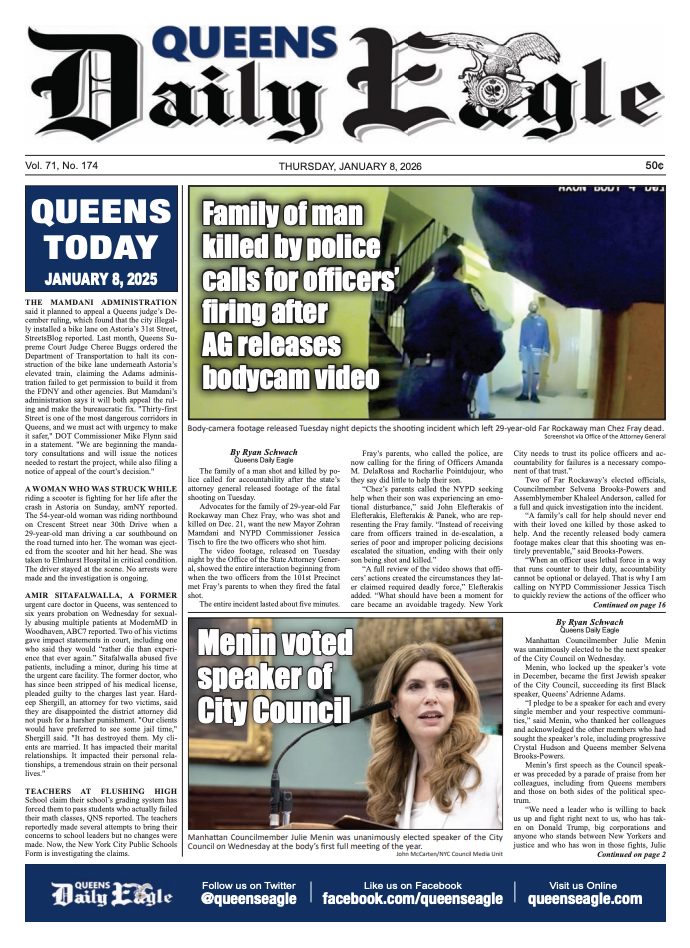VALLONE: Equipping City Schools to Best Protect Our Students
/District 19 Councilmember Paul Vallone. // Photo courtesy of Paul Vallone’s office.
By Paul Vallone, District 19 Council Member
There can be no debate, now is the time to address the safety of our children at our schools. As we continue to face school tragedies around our country, it is an indisputable fact that New York
City will forever have to be the most prepared.
The safety of our children must always be our top priority and it is essential that we take a top to bottom look at our school emergency preparedness.
Can there be any educational setting that doesn’t begin with providing a safe classroom?
At a recent Community Education Council meeting, following an incident at one of our public schools, a mother asked me a simple yet haunting question: is my child safe to go to school tomorrow?
In every mother’s and father’s eyes that night was fear, anger, and a plea for answers for how our schools will handle a situation that we pray will never come. Her question has stayed with me to this day and answering yes was not so simple.
Charts courtesy of Paul Vallone’s office.
We are faced with a clear disparity among our schools' safety resources and the level of preparation at every public and private school, as well as a lack of answers to many basic questions. That night, I made a promise that we can do better.
Now, that difficult process has begun.
Questions and concerns on our school safety have been raised on numerous occasions and at many public and private schools.
What is my school’s plan to handle a safety emergency or an active shooter situation? Why does my school still not have a surveillance system? Why do we have just one safety agent or crossing guard for over a thousand students, or sometimes none at all? Why can’t principals preemptively lock their doors? Why didn’t the parents have the right notice and information when their school experienced a soft or hard lock down? Is our intercom system even working? Is there a school safety plan and where can I find it?
These are the types of questions that are asked over and over again. There are many layers to this complex conversation, but what is clear is that it is one that needs to be held now.
There are two separate areas that must be addressed.
First, we must have a review of the infrastructural capabilities and resources of every school in the city. I still cannot move past the fact that over one third of our city’s schools still do not have a basic surveillance system. That means that out of the over 1,700 schools in our school system, more than five hundred are still without one.
The numbers are even more staggering in my district in Northeast Queens, where over sixty percent of the schools still do not have any type of surveillance system. How can we have a conversation about school safety when we haven’t provided the very first step necessary?
Beyond surveillance systems we must ask: is there a working intercom and communication system to every classroom; is there a working panic button for the principal and safety agent; is there a buzzer and intercom system to the main doors; does every school have at least one safety agent; can the principal lock the doors; has an updated safety plan been filed with the New York Police Department; have officers from the local precincts gone to each and every school; are they aware of each school’s unique layout in order to reduce response time.
Determining the answers to these and many more questions will be the charge of the School Emergency Preparedness Task Force that will be created by my package of school safety legislation. These bills were the topic of last week's joint hearing of the City Council's Education and Public Safety Committees. The Department of Education (DOE) and New York Police Department showed support for the goals of the task force. With their support, as well as the support of our Speaker Corey Johnson and many other Council Members, this task force will soon become a reality.
Secondly, and equally as important, is ensuring that our City recognizes the recommendations made by this task force, and invests capital funding to ensure the recommendations can be met.
What good is a plan if there is no money in the budget to fund it? This is why I have written a letter to Mayor de Blasio and the DOE, co-signed by many of my colleagues, to include an additional three hundred million dollars in the DOE’s upcoming five year capital plan. This would be triple the amount that was allocated in the previous capital plan.
Additionally, any recommendations made by the task force must also be provided for in the upcoming budget. Investments in improving school infrastructure will ensure that schools are prepared to confront emergencies of all types.
The need for scalable, non-intrusive systems that allow teachers to teach, while providing the tools necessary to respond to an emergency has never been more apparent.
New technologies and innovations can allow future schools, such as the newly unveiled Sandy Hook Elementary School, to combine the very best of safety and education. Our children deserve no less.
We can never hesitate when parents ask the question that must be answered; is my child safe at school?
What we do next to improve the safety, resources and opportunities for our students will define our City and the legacy we leave for our kids.
If we do not act now then one day we may have to answer a much more difficult question, one we never want to hear; what else could have been done?






